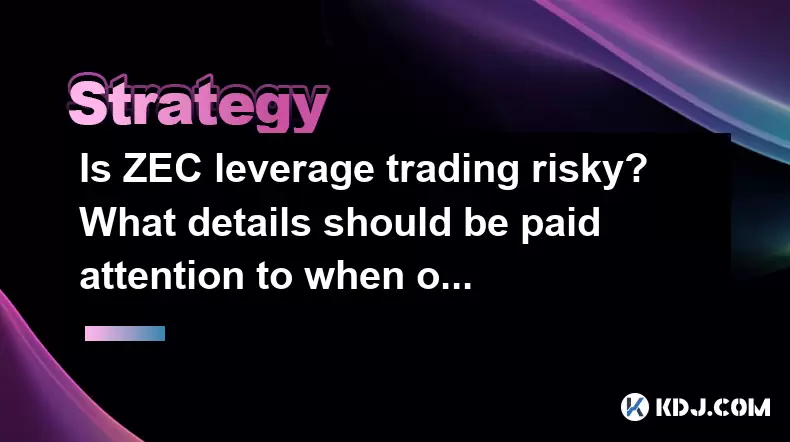-
 bitcoin
bitcoin $114684.631706 USD
-0.87% -
 ethereum
ethereum $4228.677447 USD
1.58% -
 bnb
bnb $1294.880693 USD
-1.16% -
 tether
tether $1.000819 USD
-0.02% -
 xrp
xrp $2.605138 USD
2.79% -
 solana
solana $209.908690 USD
5.89% -
 usd-coin
usd-coin $0.999903 USD
-0.03% -
 dogecoin
dogecoin $0.213423 USD
2.93% -
 tron
tron $0.322721 USD
-0.10% -
 cardano
cardano $0.727247 USD
3.66% -
 hyperliquid
hyperliquid $42.339456 USD
6.05% -
 chainlink
chainlink $19.910811 USD
5.16% -
 ethena-usde
ethena-usde $1.000557 USD
0.00% -
 stellar
stellar $0.349734 USD
2.69% -
 bitcoin-cash
bitcoin-cash $543.848687 USD
-0.21%
Is ZEC leverage trading risky? What details should be paid attention to when opening and closing positions?
ZEC leverage trading is risky due to high volatility and potential liquidation; always set stop-loss orders and monitor positions closely.
May 07, 2025 at 02:42 pm

Leverage trading in cryptocurrencies, including Zcash (ZEC), can be a lucrative yet risky endeavor. Understanding the risks involved and the intricacies of opening and closing positions is crucial for any trader looking to engage in this practice. This article will delve into the risks associated with ZEC leverage trading and provide detailed guidance on the key aspects to consider when opening and closing positions.
Understanding the Risks of ZEC Leverage Trading
Leverage trading involves borrowing funds to increase the potential return on an investment. While this can amplify profits, it also magnifies losses, making it a high-risk activity. ZEC leverage trading carries several specific risks:
- Volatility: Zcash, like other cryptocurrencies, is known for its high volatility. This can lead to significant price swings, which can result in substantial losses if the market moves against your position.
- Liquidation Risk: If the market moves adversely, you may face a margin call, where your broker demands additional funds to maintain your position. If you cannot meet this requirement, your position may be liquidated at a loss.
- Interest Costs: Borrowing funds to trade on leverage incurs interest costs, which can eat into your profits or increase your losses.
- Regulatory Risks: The regulatory environment for cryptocurrencies is still evolving, and changes in regulations can impact the value of ZEC and your ability to trade it.
Preparing to Trade ZEC with Leverage
Before diving into ZEC leverage trading, it is essential to prepare adequately. Here are some steps to take:
- Educate Yourself: Understand the basics of Zcash, its technology, and the factors that influence its price. Familiarize yourself with the concept of leverage and how it works.
- Choose a Reliable Platform: Select a reputable exchange or broker that offers ZEC leverage trading. Ensure they have robust security measures and a user-friendly interface.
- Start Small: Begin with a small amount of leverage to understand how it works and to minimize potential losses.
- Set Clear Goals and Limits: Define your trading goals and set stop-loss and take-profit levels to manage your risk effectively.
Opening a ZEC Leverage Position
Opening a leverage position in ZEC involves several steps. Here is a detailed guide on how to do it:
- Select a Trading Platform: Log into your chosen trading platform that supports ZEC leverage trading.
- Navigate to the ZEC Trading Section: Find the section where ZEC is traded. This is often labeled as 'ZEC/USD' or similar, depending on the trading pair you choose.
- Choose the Leverage Level: Decide on the amount of leverage you want to use. This is usually expressed as a ratio (e.g., 10:1, 50:1).
- Enter the Trade Details: Specify the amount of ZEC you wish to trade and the direction (long or short). Enter your stop-loss and take-profit levels to manage your risk.
- Review and Confirm: Double-check all the details of your trade, including the leverage level, trade amount, and risk management settings. Confirm the trade once you are satisfied.
Monitoring Your ZEC Leverage Position
Once your position is open, it is crucial to monitor it closely. Key aspects to watch include:
- Price Movements: Keep an eye on the ZEC price and how it moves relative to your entry point. Use technical analysis tools to identify potential trends and reversals.
- Margin Levels: Monitor your margin levels to ensure you have enough funds to maintain your position. If the market moves against you, you may need to add more funds to avoid liquidation.
- Market News and Events: Stay informed about news and events that could impact the ZEC price, such as regulatory changes, technological developments, or market sentiment shifts.
Closing a ZEC Leverage Position
Closing a leverage position in ZEC is as important as opening one. Here is how to do it effectively:
- Decide When to Close: Based on your analysis and risk management strategy, decide whether to close your position at a profit or to cut your losses.
- Navigate to the Open Positions Section: Go to the section of your trading platform where your open positions are listed.
- Select the ZEC Position: Find the ZEC position you wish to close and select it.
- Choose the Closure Option: Decide whether to close the entire position or a portion of it. Some platforms allow you to close part of your position to lock in profits while keeping the rest open.
- Confirm the Closure: Review the details of your closure, including any fees or commissions, and confirm the closure of your position.
Managing Risks in ZEC Leverage Trading
Effective risk management is crucial for success in ZEC leverage trading. Here are some strategies to consider:
- Use Stop-Loss Orders: Always set a stop-loss order to limit potential losses. This will automatically close your position if the market moves against you beyond a certain point.
- Diversify Your Portfolio: Do not put all your funds into a single ZEC leverage position. Diversify your investments to spread the risk.
- Regularly Review Your Positions: Continuously monitor and review your open positions to ensure they align with your trading strategy and risk tolerance.
- Stay Informed: Keep up-to-date with market news and developments that could affect ZEC prices. Adjust your positions accordingly to manage risks.
Frequently Asked Questions
Q: Can I use automated trading bots for ZEC leverage trading?A: Yes, many trading platforms support the use of automated trading bots for ZEC leverage trading. These bots can execute trades based on predefined criteria, helping to manage your positions more efficiently. However, it is essential to thoroughly test and monitor these bots to ensure they align with your trading strategy and risk tolerance.
Q: What are the tax implications of ZEC leverage trading?A: The tax implications of ZEC leverage trading can vary depending on your jurisdiction. Generally, profits from trading are considered taxable income, and losses can be used to offset gains. It is advisable to consult with a tax professional to understand the specific tax obligations in your region.
Q: How can I mitigate the impact of high volatility in ZEC leverage trading?A: To mitigate the impact of high volatility in ZEC leverage trading, consider using lower leverage ratios, setting tight stop-loss orders, and diversifying your portfolio. Additionally, staying informed about market trends and using technical analysis can help you make more informed trading decisions.
Q: Are there any specific indicators I should use for ZEC leverage trading?A: Some popular technical indicators for ZEC leverage trading include Moving Averages, Relative Strength Index (RSI), and Bollinger Bands. These indicators can help you identify trends, overbought/oversold conditions, and potential price breakouts. However, it is essential to combine these indicators with fundamental analysis and market news for a comprehensive trading strategy.
Disclaimer:info@kdj.com
The information provided is not trading advice. kdj.com does not assume any responsibility for any investments made based on the information provided in this article. Cryptocurrencies are highly volatile and it is highly recommended that you invest with caution after thorough research!
If you believe that the content used on this website infringes your copyright, please contact us immediately (info@kdj.com) and we will delete it promptly.
- XRP Price Prediction: Weekend Rollercoaster or Rally?
- 2025-10-12 08:45:16
- Bittensor (TAO): Super Bullish Signals Point to Potential 2x Rally
- 2025-10-11 10:25:12
- Silver Price Correction: Navigating the Dip & Identifying Key SEO Keywords
- 2025-10-11 10:25:12
- Decoding Crypto Trends: Bittensor's Bull Run, Cardano's Dip, and LivLive's Presale Buzz in 'Uptober 2025'
- 2025-10-12 08:45:16
- MoonBull: The Crypto Meme Coin Promising 1000x Gains?
- 2025-10-11 10:30:01
- Crypto Payroll Revolution: Stablecoins, Altcoins, and the Future of Salary Payments
- 2025-10-11 10:30:01
Related knowledge

Practical parameter settings for a Bitcoin multi-timeframe moving average system
Sep 18,2025 at 10:54pm
Optimizing Timeframe Combinations for Bitcoin Trading1. Selecting appropriate timeframes is crucial when building a multi-timeframe moving average sys...

How can I filter out false breakouts in Dogecoin high-frequency trading?
Sep 22,2025 at 01:00am
Understanding False Breakouts in Dogecoin Trading1. A false breakout occurs when Dogecoin's price appears to move beyond a defined support or resistan...

Techniques for identifying tops and bottoms in the Bitcoin on-chain NVT model
Sep 20,2025 at 07:54pm
Understanding the NVT Model in Bitcoin Analysis1. The Network Value to Transactions (NVT) ratio is often described as the 'P/E ratio' of the cryptocur...

What does the surge in open interest in Bitcoincoin futures mean?
Sep 20,2025 at 11:18pm
Understanding the Surge in Dogecoin Futures Open Interest1. A surge in open interest within Dogecoin futures indicates a growing number of active cont...

How can I use the Ethereum USDT premium to gauge market sentiment?
Sep 18,2025 at 11:55pm
Understanding the Ethereum USDT Premium1. The Ethereum USDT premium refers to the price difference between USDT (Tether) traded on Ethereum-based plat...

What should I do if Ethereum staking yields decline?
Sep 20,2025 at 06:18am
Understanding the Causes Behind Declining Ethereum Staking Yields1. The Ethereum network transitioned to a proof-of-stake consensus mechanism with the...

Practical parameter settings for a Bitcoin multi-timeframe moving average system
Sep 18,2025 at 10:54pm
Optimizing Timeframe Combinations for Bitcoin Trading1. Selecting appropriate timeframes is crucial when building a multi-timeframe moving average sys...

How can I filter out false breakouts in Dogecoin high-frequency trading?
Sep 22,2025 at 01:00am
Understanding False Breakouts in Dogecoin Trading1. A false breakout occurs when Dogecoin's price appears to move beyond a defined support or resistan...

Techniques for identifying tops and bottoms in the Bitcoin on-chain NVT model
Sep 20,2025 at 07:54pm
Understanding the NVT Model in Bitcoin Analysis1. The Network Value to Transactions (NVT) ratio is often described as the 'P/E ratio' of the cryptocur...

What does the surge in open interest in Bitcoincoin futures mean?
Sep 20,2025 at 11:18pm
Understanding the Surge in Dogecoin Futures Open Interest1. A surge in open interest within Dogecoin futures indicates a growing number of active cont...

How can I use the Ethereum USDT premium to gauge market sentiment?
Sep 18,2025 at 11:55pm
Understanding the Ethereum USDT Premium1. The Ethereum USDT premium refers to the price difference between USDT (Tether) traded on Ethereum-based plat...

What should I do if Ethereum staking yields decline?
Sep 20,2025 at 06:18am
Understanding the Causes Behind Declining Ethereum Staking Yields1. The Ethereum network transitioned to a proof-of-stake consensus mechanism with the...
See all articles










































































